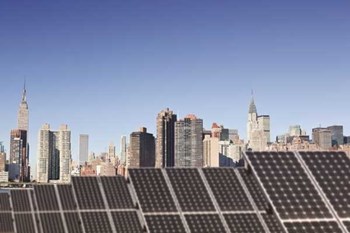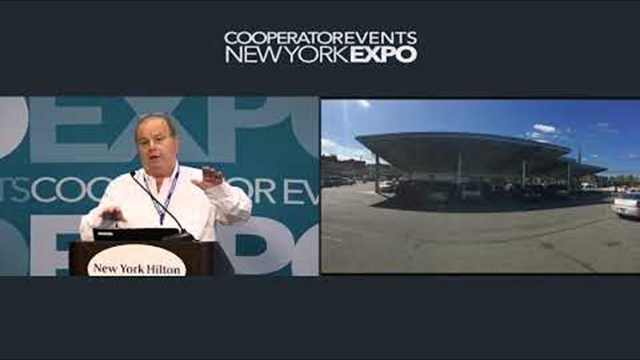
Mom was right. Her admonition to “Turn out the lights when you leave the room!” is as valid today as it was a generation ago. And yet many co-op and condo buildings, while energy-conscious in so many ways, seem to feel it’s better to just leave the lights on—sometimes, 24/7.
Why? Well, the argument goes, it takes more energy, or produces more wear and tear, to start them up again than it does to just leave them burning.
And then there's the fashionable trend of using bamboo or cork for flooring, rather than traditional hardwoods, and replacing old-school incandescent light bulbs with new-and-improved models.
But do all these "greening" measures really do as much good as we like to think they do? Are buildings that encourage (or even mandate) that owners install low-flow toilets and spirally-shaped light bulbs really saving themselves money? The answer isn't always clear-cut, say some experts.
On, or Off?
“It’s a popular myth that turning bulbs on and off will make them die faster,” says Nancy Hazard of Greenfield, Massachusetts, former director of the Northeast Sustainable Energy Association (NESEA) and a volunteer with Greening Greenfield.
The roots of that myth may well be traced to earlier days of the computer age, when experts opined that it was better to leave a computer running than to power it on and off—moves that, if nothing else, put a strain on the system’s mechanical components. Today, computers tend to drop into an energy-saving “sleep” mode when not in active use, as do a host of other electrical and electronic devices found in the average building.
Unfortunately, the advent of new energy-saving products has compounded some of the misguided ideas: Because the new compact fluorescent bulbs installed in a community use much less energy than the old incandescent bulbs, it’s okay to leave them on longer. You’re still saving energy, right?
“Maybe you should be thinking about what lights you really need,” Hazard says. “Do you just need a little light to get your keys out of your pocket and into the keyhole? Or do you need enough light for a party on the patio?” When swapping out bulbs, she suggests, homeowners and board members should think beyond “replacement” and really assess their needs. There’s a whole new generation of products out there, and thinking hasn’t always kept pace with innovation.
Bamboo or Bust
So if your kitchen floors are plain old linoleum or tile and you don't have a solar array on your roof, does that mean that you're out of step with the new environmentally friendly standards of the day? Not necessarily, say the pros.
"When people hear ‘green,’ a lot of times they think of bamboo flooring or hemp drapes or things like that,” says Mike Rogers, president of OmStout Consulting in Vermont, and a nationally recognized expert in residential energy-efficiency. “But really where you ought to be starting is with energy efficiency, the durability of the building, and the health and safety of the people living in it. If you put down bamboo flooring or organic drapes, but you have mold, or if there are unsafe conditions from lead paint or a backdrafting water heater, what the heck difference does the flooring make? It's not to say that those things aren't important and we shouldn't consider them, but what you really need to start with is how the building itself is performing."
Kirsten Thoft, an architect who renovated a condo in Princeton, New Jersey to achieve the National Green Building Standard's Emerald Level classification agrees. "I think that laypeople tend to think first about materials like 'Oh, we need to replace our floors, or we should get recycled countertops,' or something like that,” she says. "But the most important things that you can do to any building aren't sexy, and you don't even see them—which is part of the reason people overlook them. But the cost of heating and cooling and the amount of energy consumed doing those things, either oil or natural gas or electricity are huge, and easily reducible by getting an energy audit" and following its recommendations.
“What we find,” says David Unger, CEO of U.S. Energy Group, based in Fresh Meadows, “is that soon as you really start looking at what it takes to go green, you recognize that it's all about cutting energy use,” says Unger. “If I can use less oil, I'm going green by virtue of the fact that I'm not dependent on oil, I'm not emitting as much carbon. And a lot of buildings don't see that. They see going green as, ‘Well we’re going to put solar panels on our roof.’ And right now solar panels, while it's a great idea, the economics don't work out. They have an eight-year payback and you're trying to manage your operational overhead to a certain number each year and it just doesn't.work out for these owners.”
“We Can’t Do It”
“I think the biggest myth is thinking that because you live in a condo or other multifamily building, energy upgrades are difficult, if not impossible, to do,” says Gaelan Brown, an independent energy consultant and former vice president of GroSolar, a Vermont distributor and installer of solar energy solutions. “There are plenty of things that condos and condo owners can do,” he says.
“A lot of people believe they can just throw solar panels on their roof and that's going to make them green,” says Frank Dalene, a home builder and co-founder of the Hamptons Green Alliance based in Long Island, “But it’s more than that. It's taking a holistic view of the building, identifying areas that are wasteful. You should be looking at that first before you start supplementing your electrical usage with renewable energy, for example. Renewable energy is very expensive to install and there's steps that can be taken that will really give you a better bang for the buck.”
"Upgrading something like insulation would be a common improvement," says Thoft, "because it's beyond the interior of your condo unit walls. So an association would actually have to decide to do that together. But it doesn't mean that it's impossible. It requires everybody—or at least the majority—to be on board and agree that it is important. The measures we took at the building that I did are anticipated to reduce the natural gas and the electrical usage, by about 60 percent, which is huge. So I think it's certainly in people's best interest in terms of money to pursue these things."
Getting to yes is definitely possible, even if a little challenging. “Whether it is an apartment community or a large-scale condominium project, they face similar issues and concerns,” says Sarah Greenough, a media representative for Massachusetts-based Princeton Properties. “Our management concerns and options are similar from site to site regardless of the type of multifamily property.”
The payback may not be quite as attractive for a condominium due to different financial and tax ramifications than those applying to a rental property. But that doesn’t mean “going green” is impossible; the payback just might not be as speedy.
Energy and management pros alike recommend that any property considering a major energy project work with a knowledgeable and experienced consultant, and “every project requires at least one person who really has the motivation to see it through—in some cases, to relentlessly carry it through,” Brown adds.
“We’ve Done All We Can Do”
Condos built in the past couple of decades may well have insulated walls and double-pane windows, and over the past 20 years, many homeowners and associations took conservation-oriented steps. Tightening up the building envelope is a low-cost, but effective, means of saving energy—and one that many boards ignore. “People have heard that your building can be too tight and it’s not good,” Hazard says, “but unless you have a very new, super-insulated home, it probably is not tight at all.”
Another low-cost, often-overlooked source of potential savings is simply checking the settings and mechanical upkeep of your building's machinery and equipment, says Rogers.
“A lot of the buildings in the metro area have mechanical systems that are just in terrible disarray. Over the years, the controls on them, have stopped working properly. It's not uncommon to walk down the street in January and see open windows because people are trying to cool off. Some rooms are too hot, some rooms are too cold and that's just an enormous waste of energy and probably one of the least ‘green’ things that you can do. There are tremendous opportunities on the building performance side of things and that's really where people ought to start. The good news is, especially in larger condo or co-op type buildings, a lot of the solutions pay for themselves almost instantly. You get paybacks from fixing controls the first month after you've had the work done in some cases.”
A third easy way to assess your building’s energy profile is to bring in a certified energy auditor—one who arrives with a thermal imaging gun and a blower door. The uninsulated and air-leaking spots will be immediately obvious. “The science has improved astronomically in the last 30 years,” Hazard notes. Using the audit report as a guide, get out the caulk gun or hire a contractor to tighten up the envelope if necessary.
Making Us Green
As unit owners and boards have upgraded appliances and other electronics in their apartments and common areas over the years, they’ve ditched energy hogs and may feel oh, so very green.
But beware. Chances are that when you shut off your old television set, it actually went off—but with newer products, that isn’t necessarily so.
“The ‘phantom load’ is a big issue,” Brown says. “A lot of products today go into ‘ready mode’ and trickle juice even when you don’t need it.” One way to discover the drain your appliances and electronics—even brand-new ones—create is with a device called a “Kill-a-Watt.” Plug the device into an outlet, plug your appliance into it, and leave it in sleep mode for a whole day. “You may be surprised how much juice it’s using when it’s turned off,” Brown says.
When you buy new appliances, says Dalene. “One of the first appliances you want to change out and actually upgrade is your dishwasher. A dishwasher that was not Energy Star-rated is the greatest energy hog. The great thing about Energy Star is that it's a great example of a voluntary program actually working. It brought the entire industry up to what the Energy Star rating is for. It’s a great thing, there’s great stuff happening. Really, the awareness is what’s important and that’s what you are doing."
It’s that awareness that makes the difference—so forget the myths, the experts suggest. Take a hard look at your habits, do some research, and see how much greener your home can be. “I think a big misconception is that going green in some way equates to a premium having to be paid for having some sort of social responsibility,” says Unger. “That’s the big thing, that going green costs money. If you can cut your oil expense by 20 percent over the course of the year, that’s going green. And you’re winning both ways; you’re saving money and you’re actually being socially responsible at the same time.”
Pat Gale is the associate editor of New England Condominium magazine, a Yale Robbins, Inc. publication.









Leave a Comment